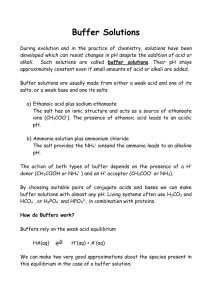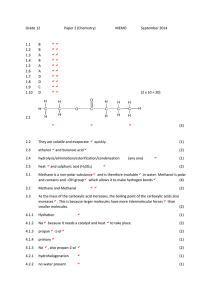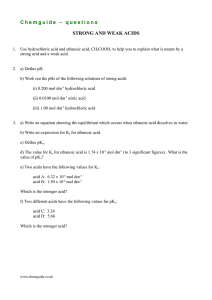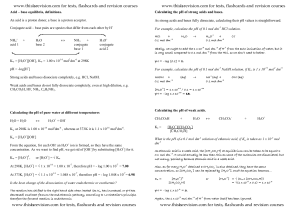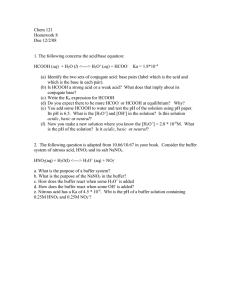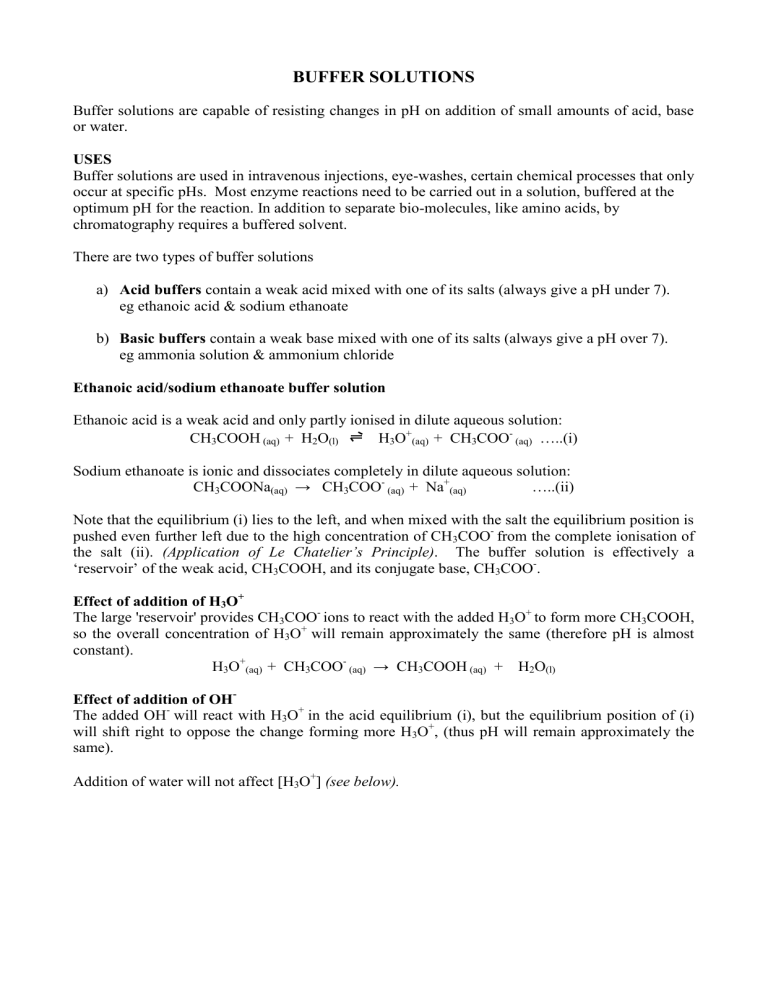
BUFFER SOLUTIONS Buffer solutions are capable of resisting changes in pH on addition of small amounts of acid, base or water. USES Buffer solutions are used in intravenous injections, eye-washes, certain chemical processes that only occur at specific pHs. Most enzyme reactions need to be carried out in a solution, buffered at the optimum pH for the reaction. In addition to separate bio-molecules, like amino acids, by chromatography requires a buffered solvent. There are two types of buffer solutions a) Acid buffers contain a weak acid mixed with one of its salts (always give a pH under 7). eg ethanoic acid & sodium ethanoate b) Basic buffers contain a weak base mixed with one of its salts (always give a pH over 7). eg ammonia solution & ammonium chloride Ethanoic acid/sodium ethanoate buffer solution Ethanoic acid is a weak acid and only partly ionised in dilute aqueous solution: CH3COOH (aq) + H2O(l) H3O+(aq) + CH3COO- (aq) …..(i) Sodium ethanoate is ionic and dissociates completely in dilute aqueous solution: CH3COONa(aq) → CH3COO- (aq) + Na+(aq) …..(ii) Note that the equilibrium (i) lies to the left, and when mixed with the salt the equilibrium position is pushed even further left due to the high concentration of CH3COO- from the complete ionisation of the salt (ii). (Application of Le Chatelier’s Principle). The buffer solution is effectively a ‘reservoir’ of the weak acid, CH3COOH, and its conjugate base, CH3COO-. Effect of addition of H3O+ The large 'reservoir' provides CH3COO- ions to react with the added H3O+ to form more CH3COOH, so the overall concentration of H3O+ will remain approximately the same (therefore pH is almost constant). H3O+(aq) + CH3COO- (aq) → CH3COOH (aq) + H2O(l) Effect of addition of OHThe added OH- will react with H3O+ in the acid equilibrium (i), but the equilibrium position of (i) will shift right to oppose the change forming more H3O+, (thus pH will remain approximately the same). Addition of water will not affect H3O+ (see below). Ammonia solution/ammonium chloride buffer solution Ammonia is a weak base and only partly ionised in dilute aqueous solution: NH3 (aq) + H2O(l) NH4+(aq) + OH- (aq) …..(iii) Ammonium chloride is ionic and dissociates completely in dilute aqueous solution: NH4Cl(s) + aq → NH4+ (aq) + Cl- (aq) …..(iv) Note that the equilibrium (iii) lies to the left, and when mixed with the salt the equilibrium position is pushed even further left due to the high concentration of NH4+ from the complete ionisation of the salt (iv). (application of Le Chatelier’s Principle). The buffer solution is effectively a ‘reservoir’ of the weak base, NH3, and its conjugate acid, NH4+. Effect of addition of OHThe large 'reservoir' provides NH4+ ions to react with the added OH- to form more H2O, so the overall concentration of H3O+ will remain approximately the same (therefore pH is almost constant). NH4+(aq) + OH- (aq) → NH3 (aq) + H2O(l) Effect of addition of H3O+ The added H3O+ will react with OH- in the equilibrium (iii), and the equilibrium position of (iii) will shift right to oppose the decrease in [OH-], (thus pH will remain approximately the same). Addition of water will not affect H3O+ (see below) CALCULATION OF pH OF BUFFER SOLUTIONS Consider a weak acid, HA and it’s salt NaA: NaA(aq) + aq → HA (aq) + H2O(l) A- (aq) + Na+(aq) H3O+(aq) + A- (aq) The high concentration of A- ions from the complete dissociation of the salt, suppresses the dissociation of the weak acid still further. We can assume that the degree of ionisation of the acid is negligible so, HAeqm ≈ HAinitial ≈ acid and the acid makes no significant contribution to A- which is almost all contributed by the salt so, A- ≈ salt. Ka = H3O+A- HA Ka = H3O+salt acid Rearranging to make H3O+ the subject: H3O+ = Ka x acid salt This formula can be used to solve calculations on buffer solutions. Note that addition of water to a buffer solution decreases [acid] and [salt] to the same extent so that H3O+ and pH is unaffected. Taking logs: log10 H3O+ = log10Ka + log10 acid] salt -log10H3O+ = -log10Ka - log10 acid salt + pH = -log10H3O and pKa = -log10Ka changing sign: as pH = pKa - log10 acid salt pH = pKa + log10 salt This is known as the 'Henderson Equation' and can acid also be used to solve buffer calculations. Worked examples: a) Calculate pH of a weak acid, HX, with a Ka of 2.00 x 10-3 mol dm-3, if the concentration of the salt, NaX, is 0.1 mol dm-3 and the acid is 0.2 mol dm-3. or H3O+ = Ka x acid salt pH = -log10H3O+ b) = 2.00 x 10-3 x 0.2 0.1 = 4.00 x 10-3 mol dm-3 = -log10 (4.00 x 10-3 ) = 2.4 A weak acid, HZ, has a Ka of 3.5 x 10-5 mol dm-3. What ratio of acid/salt is necessary to give a buffer solution of pH 4.1? pH = -log10H3O+ = 4.1, H3O+ = Ka x acid , salt H3O+ = acid Ka salt H3O+ = 10-4.1 = 7.94 x 10-5 mol dm-3 7.94 x 10-5 = 3.5 x 10-5 x [acid] salt = 7.94 x 10-5 = [acid] 3.5 x 10-5 salt = 2.27 1. Three solutions contain propanoic acid (Ka = 1.34 x 10-5 mol dm-3) at a concentration of 0.10 mol dm-3, and sodium propanoate at concentrations of a) 0.10 mol dm-3 , b) 0.20 mol dm-3 and c) 0.50 mol dm-3. Calculate the pH values of the three buffer solutions. 2. a) What is the pH of a solution containing 0.10 mol of ethanoic acid (Ka = 1.86 x 10-5 mol dm-3) in 1 dm3. b) How would the pH of the solution in (a) change if 0.10 mol of sodium ethanoate was added? c) How many moles of sodium ethanoate must be added to 1 dm3 of 0.01 mol dm-3 ethanoic acid to produce a buffer solution of pH 5.8? 3. A solution of ethanoic acid and sodium ethanoate acts as a buffer solution. a) What is meant by the term buffer solution? b) Why must sodium ethanoate be added to ethanoic acid in order to obtain the buffering effect? c) Calculate the pH of a solution containing 30 g ethanoic acid (Ka = 1.7 x 10-5 mol dm-3) and 82 g of sodium ethanoate in 1 dm3 of solution. d) What mass of ethanoic acid must be added to the buffer solution in (c) to produce a buffer solution of pH 5. Answers: 1(a) 4.87, (b) 5.17, (c) 5.57, 2(a) 2.87, (b) 4.73, (c) 0.117 mol 3(c) 5.1, (d) 5.3 g
